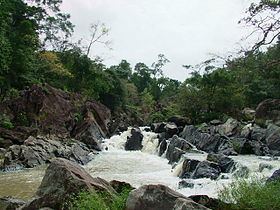Country Vietnam Time zone ICT (UTC+7) Area 13,062 km² Capital Buon Ma Thuot University Tay Nguyen University | Region Central Highlands Website www.daklak.gov.vn Population 1.833 million (2014) ISO 3166 code Vietnam | |
 | ||
Area codes 262 (from 17 June 2017
500 (until 16 July 2017) Points of interest Thác Đray Nur, Thác Bảy Nhánh, Bảo tàng các dân tộc Việt Nam, Chùa Khải Đoan, Tượng đài Chiến thắng Bu Destinations Buon Ma Thuot, Buôn Đôn District, Lắk District, Ea Súp District, Cư M'gar District | ||
Đắk Lắk ([ɗák lák]) is a province of Vietnam. The name is also spelled Đắc Lắc, which is more in keeping with Vietnamese spelling, and occasionally Darlac, but the official spelling is Đắk Lắk. It is located in Vietnam's Central Highlands, and is home to a high number of indigenous people who are not ethnically Vietnamese (Việt).
Contents
- Map of C490E1BAAFk LE1BAAFk Province Vietnam
- History
- Geography
- Administrative divisions
- Economy
- References
Map of %C4%90%E1%BA%AFk L%E1%BA%AFk Province, Vietnam
History
The area now known as Đắk Lắk was originally controlled by the Kingdom of Champa. When Champa was conquered and annexed by Vietnam in the 15th century, Đắk Lắk was brought under loose Vietnamese rule. Later, in 1540, a noble named Bùi Tá Hán was appointed by the Vietnamese authorities to direct the settlement of the area by ethnic Vietnamese, bringing the highlands under more effective Vietnamese control. Military outposts were established in the area to guard against possible aggression from the west. Later, when Vietnam was occupied by the French, the French established a large number of plantations in the area. Resistance to French rule was strong in Đắk Lắk, with various minority tribes leading a number of significant rebellions. The most notable was a 23-year campaign led by N’Trang Lơng, a M’Nông tribal leader. Later, Đắk Lắk was part of South Vietnam, and saw considerable action in the Vietnam War.
Until recently, Đắk Nông was a part of Đắk Lắk, but is now a separate province.
A chronology of key events
Part of M'Đrăk district was added to Khánh Hòa Province
Geography
Đắk Lắk is based around the Đắk Lắk Plateau, around six hundred metres above sea level.
About 60 km south of Buôn Ma Thuột is Lăk Lake. Overlooking the lake is the old summer residence of Emperor Bảo Đại which has been renovated into a hotel. Surrounding the lake is Jun Village, home of the Jun people. The villagers have a peculiar form of fishing where they attach metal rods to a car battery and run the rods through the water zapping and stunning the fish and then collecting them to keep in a tank at the village until they are needed.
Administrative divisions
Đắk Lắk is subdivided into 15 district-level sub-divisions:
They are further subdivided into 12 commune-level towns (or townlets), 152 communes, and 20 wards.
Economy
Coffee, fruit, and rubber play an important part in its economy. Recently, there have been efforts to harness the province's considerable potential for hydroelectric generation. The Jun people take advantage of the small tourist trade that passes through, giving elephant rides through the village and across the lake.
